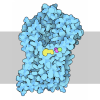[English] 日本語
 Yorodumi
Yorodumi- PDB-7npw: Cryo-EM structure of Human excitatory amino acid transporters-1 (... -
+ Open data
Open data
- Basic information
Basic information
| Entry | Database: PDB / ID: 7npw | ||||||
|---|---|---|---|---|---|---|---|
| Title | Cryo-EM structure of Human excitatory amino acid transporters-1 (EAAT1) in potassium buffer | ||||||
 Components Components | Excitatory amino acid transporter 1 | ||||||
 Keywords Keywords | MEMBRANE PROTEIN / Human Membrane Protein / Transporter / Glutamate transporter | ||||||
| Function / homology |  Function and homology information Function and homology informationDefective SLC1A3 causes episodic ataxia 6 (EA6) / Astrocytic Glutamate-Glutamine Uptake And Metabolism / cranial nerve development / gamma-aminobutyric acid biosynthetic process / neurotransmitter uptake / cell morphogenesis involved in neuron differentiation / membrane protein complex / high-affinity L-glutamate transmembrane transporter activity / glutamate:sodium symporter activity / L-glutamate import ...Defective SLC1A3 causes episodic ataxia 6 (EA6) / Astrocytic Glutamate-Glutamine Uptake And Metabolism / cranial nerve development / gamma-aminobutyric acid biosynthetic process / neurotransmitter uptake / cell morphogenesis involved in neuron differentiation / membrane protein complex / high-affinity L-glutamate transmembrane transporter activity / glutamate:sodium symporter activity / L-glutamate import / : / L-glutamate transmembrane transporter activity / L-glutamate transmembrane transport / D-aspartate import across plasma membrane / L-aspartate import across plasma membrane / Glutamate Neurotransmitter Release Cycle / neutral L-amino acid transmembrane transporter activity / auditory behavior / L-glutamate import across plasma membrane / transepithelial transport / intracellular sodium ion homeostasis / cellular response to cocaine / glutamate binding / neuromuscular process controlling balance / neurotransmitter transport / response to light stimulus / positive regulation of synaptic transmission / transport across blood-brain barrier / monoatomic ion transport / potassium ion transmembrane transport / chloride transmembrane transport / basal plasma membrane / sensory perception of sound / response to wounding / cytoplasmic vesicle / chemical synaptic transmission / neuron projection / response to xenobiotic stimulus / response to antibiotic / neuronal cell body / synapse / perinuclear region of cytoplasm / cell surface / metal ion binding / membrane / plasma membrane Similarity search - Function | ||||||
| Biological species |  Homo sapiens (human) Homo sapiens (human) | ||||||
| Method | ELECTRON MICROSCOPY / single particle reconstruction / cryo EM / Resolution: 3.99 Å | ||||||
 Authors Authors | Kumar, A. / Reyes, N. | ||||||
| Funding support |  France, 1items France, 1items
| ||||||
 Citation Citation |  Journal: EMBO J / Year: 2022 Journal: EMBO J / Year: 2022Title: The ion-coupling mechanism of human excitatory amino acid transporters. Authors: Juan C Canul-Tec / Anand Kumar / Jonathan Dhenin / Reda Assal / Pierre Legrand / Martial Rey / Julia Chamot-Rooke / Nicolas Reyes /  Abstract: Excitatory amino acid transporters (EAATs) maintain glutamate gradients in the brain essential for neurotransmission and to prevent neuronal death. They use ionic gradients as energy source and co- ...Excitatory amino acid transporters (EAATs) maintain glutamate gradients in the brain essential for neurotransmission and to prevent neuronal death. They use ionic gradients as energy source and co-transport transmitter into the cytoplasm with Na and H , while counter-transporting K to re-initiate the transport cycle. However, the molecular mechanisms underlying ion-coupled transport remain incompletely understood. Here, we present 3D X-ray crystallographic and cryo-EM structures, as well as thermodynamic analysis of human EAAT1 in different ion bound conformations, including elusive counter-transport ion bound states. Binding energies of Na and H , and unexpectedly Ca , are coupled to neurotransmitter binding. Ca competes for a conserved Na site, suggesting a regulatory role for Ca in glutamate transport at the synapse, while H binds to a conserved glutamate residue stabilizing substrate occlusion. The counter-transported ion binding site overlaps with that of glutamate, revealing the K -based mechanism to exclude the transmitter during the transport cycle and to prevent its neurotoxic release on the extracellular side. | ||||||
| History |
|
- Structure visualization
Structure visualization
| Movie |
 Movie viewer Movie viewer |
|---|---|
| Structure viewer | Molecule:  Molmil Molmil Jmol/JSmol Jmol/JSmol |
- Downloads & links
Downloads & links
- Download
Download
| PDBx/mmCIF format |  7npw.cif.gz 7npw.cif.gz | 224.8 KB | Display |  PDBx/mmCIF format PDBx/mmCIF format |
|---|---|---|---|---|
| PDB format |  pdb7npw.ent.gz pdb7npw.ent.gz | 182 KB | Display |  PDB format PDB format |
| PDBx/mmJSON format |  7npw.json.gz 7npw.json.gz | Tree view |  PDBx/mmJSON format PDBx/mmJSON format | |
| Others |  Other downloads Other downloads |
-Validation report
| Arichive directory |  https://data.pdbj.org/pub/pdb/validation_reports/np/7npw https://data.pdbj.org/pub/pdb/validation_reports/np/7npw ftp://data.pdbj.org/pub/pdb/validation_reports/np/7npw ftp://data.pdbj.org/pub/pdb/validation_reports/np/7npw | HTTPS FTP |
|---|
-Related structure data
| Related structure data |  12524MC 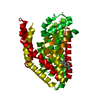 7awlC  7awmC  7awnC  7awpC  7awqC M: map data used to model this data C: citing same article ( |
|---|---|
| Similar structure data |
- Links
Links
- Assembly
Assembly
| Deposited unit | 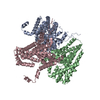
|
|---|---|
| 1 |
|
- Components
Components
| #1: Protein | Mass: 51078.273 Da / Num. of mol.: 3 Source method: isolated from a genetically manipulated source Source: (gene. exp.)  Homo sapiens (human) / Gene: SLC1A3, EAAT1, GLAST, GLAST1 / Plasmid: pcDNA3.1 + / Cell line (production host): HEK293F / Production host: Homo sapiens (human) / Gene: SLC1A3, EAAT1, GLAST, GLAST1 / Plasmid: pcDNA3.1 + / Cell line (production host): HEK293F / Production host:  Homo sapiens (human) / References: UniProt: P43003 Homo sapiens (human) / References: UniProt: P43003 |
|---|
-Experimental details
-Experiment
| Experiment | Method: ELECTRON MICROSCOPY |
|---|---|
| EM experiment | Aggregation state: PARTICLE / 3D reconstruction method: single particle reconstruction |
- Sample preparation
Sample preparation
| Component | Name: Human excitatory amino acid transporter 1 / Type: COMPLEX / Entity ID: all / Source: RECOMBINANT | ||||||||||||||||||||||||||||||
|---|---|---|---|---|---|---|---|---|---|---|---|---|---|---|---|---|---|---|---|---|---|---|---|---|---|---|---|---|---|---|---|
| Molecular weight | Experimental value: NO | ||||||||||||||||||||||||||||||
| Source (natural) | Organism:  Homo sapiens (human) Homo sapiens (human) | ||||||||||||||||||||||||||||||
| Source (recombinant) | Organism:  Homo sapiens (human) / Cell: HEK-293F / Plasmid: pcDNA3.1 Homo sapiens (human) / Cell: HEK-293F / Plasmid: pcDNA3.1 | ||||||||||||||||||||||||||||||
| Buffer solution | pH: 7.4 | ||||||||||||||||||||||||||||||
| Buffer component |
| ||||||||||||||||||||||||||||||
| Specimen | Conc.: 4 mg/ml / Embedding applied: NO / Shadowing applied: NO / Staining applied: NO / Vitrification applied: YES | ||||||||||||||||||||||||||||||
| Specimen support | Grid material: GOLD / Grid mesh size: 300 divisions/in. / Grid type: Quantifoil R1.2/1.3 | ||||||||||||||||||||||||||||||
| Vitrification | Instrument: FEI VITROBOT MARK IV / Cryogen name: ETHANE / Humidity: 100 % / Chamber temperature: 277.15 K / Details: Grids were blotted for 4 Sec |
- Electron microscopy imaging
Electron microscopy imaging
| Experimental equipment |  Model: Titan Krios / Image courtesy: FEI Company |
|---|---|
| Microscopy | Model: FEI TITAN KRIOS |
| Electron gun | Electron source:  FIELD EMISSION GUN / Accelerating voltage: 300 kV / Illumination mode: FLOOD BEAM FIELD EMISSION GUN / Accelerating voltage: 300 kV / Illumination mode: FLOOD BEAM |
| Electron lens | Mode: BRIGHT FIELD / Nominal defocus max: 2000 nm / Nominal defocus min: 800 nm / Cs: 2.7 mm / C2 aperture diameter: 50 µm |
| Specimen holder | Cryogen: NITROGEN |
| Image recording | Electron dose: 42.3 e/Å2 / Detector mode: COUNTING / Film or detector model: GATAN K2 SUMMIT (4k x 4k) / Num. of grids imaged: 1 / Num. of real images: 13607 |
| Image scans | Movie frames/image: 40 / Used frames/image: 1-40 |
- Processing
Processing
| Software | Name: PHENIX / Version: 1.18.2_3874: / Classification: refinement | ||||||||||||||||||||||||||||||||||||||||
|---|---|---|---|---|---|---|---|---|---|---|---|---|---|---|---|---|---|---|---|---|---|---|---|---|---|---|---|---|---|---|---|---|---|---|---|---|---|---|---|---|---|
| EM software |
| ||||||||||||||||||||||||||||||||||||||||
| CTF correction | Details: Gctf / Type: PHASE FLIPPING AND AMPLITUDE CORRECTION | ||||||||||||||||||||||||||||||||||||||||
| Particle selection | Num. of particles selected: 2298481 | ||||||||||||||||||||||||||||||||||||||||
| Symmetry | Point symmetry: C3 (3 fold cyclic) | ||||||||||||||||||||||||||||||||||||||||
| 3D reconstruction | Resolution: 3.99 Å / Resolution method: FSC 0.143 CUT-OFF / Num. of particles: 34433 / Num. of class averages: 1 / Symmetry type: POINT | ||||||||||||||||||||||||||||||||||||||||
| Atomic model building | Protocol: RIGID BODY FIT / Space: REAL Details: For model building, the scaD and tranD of Rb+/Ba2+ bound X-ray structure were fitted into the EM map as separate rigid-bodies using Chimera. | ||||||||||||||||||||||||||||||||||||||||
| Refine LS restraints |
|
 Movie
Movie Controller
Controller


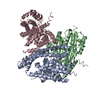
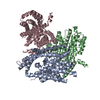
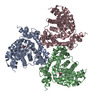
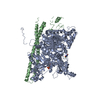




 PDBj
PDBj